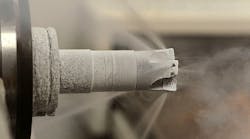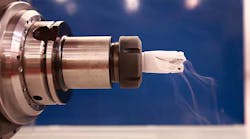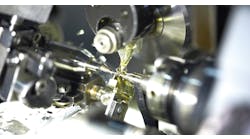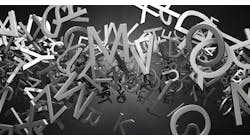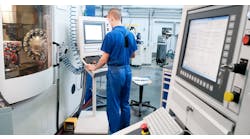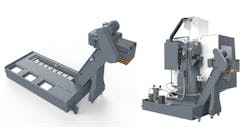The demand for extra hard materials in highly engineered components and systems like aerospace, energy, and medical and surgical devices continues to grow steadily. Already firmly established in those high-tech and precision engineering sectors, the use of titanium and its alloys is becoming widespread now. Light, strong and offering excellent corrosion resistance, these materials are increasingly preferred as replacement options for high-nickel alloys. This adoption is not without challenges.
The impact of titanium-based alloys on machining systems — and in particular on tool life — can be problematic if not properly tackled prior to implementation. However, the popularity of this robust material will only continue to grow as new processes emerge that reduce costs, making titanium and its alloys more accessible.
Positive properties — Titanium has many properties that make it attractive to certain industries. Titanium is super light, has twice the strength of steel, and is highly elastic, making it easier to mold. In aerospace, where even a small reduction in weight can bring many millions of dollars’ worth of savings, the rate of titanium consumption is understandably very high. Calculations show that every pound in weight that can be reduced on an aircraft saves $1 million in operating cost over the life of the aircraft.
In addition to its lightness and strength, it is titanium’s compatibility with human biology that has led to it being used in the production of implants. One of the most important uses of titanium was in artificial hearts, first implanted into a human in 2001. Other medical applications include hip replacements, elbow and hip joints, and pacemakers.
Tackling the titanium challenge — Despite these advantages to the designer and consumer, titanium is notoriously difficult to machine. And, the difficulties presented in machining the material itself also negatively impact tool life. Since titanium’s heat conductivity is low, it will flex and return to its original shape a lot more easily than steel or high-nickel alloys. The downside of this is experienced during machining: the heat from the operation does not transfer into the part itself or dissipate from the tool edge, which can shorten tool life.
This issue is compounded by the tight tolerances demanded by manufacturers in those industries that currently have the greatest need for titanium parts. For aerospace, the tolerances are to within a thousandth of an inch, and if violated, the part must be scrapped. Achieving such tolerances while using such a malleable material is difficult, and wear on the cutters increases significantly compared to similar efforts with nickel and chromium alloys.
Also, consideration must be given to minimizing stickiness during cutting, which will quickly damage the tool, and to avoiding any cross-contamination, to which titanium is prone. Ensuring that materials and machines are completely clean prior to machining is critical to overcoming these factors.
There are a number of titanium alloys, each with its own specific characteristics and properties, and each with its own machining challenges. The cost and limited availability of titanium means avoiding scrap, and so it is critical for the machine shops to execute their production of titanium parts in the most efficient way possible. Specifying the most appropriate material is a part in this, as is understanding the particular machining requirements. For example, some alloys are easier to machine than others, which affects the volume and type of cutting fluid selected, to maximize tool performance. Currently, the most commonly machined alloy is Titanium 6-4, so called because it has 6% aluminum and 4% vanadium, a combination that promotes machinability.
The tooling industry continually develops and introduces methods and technologies that make cutting titanium more effective, including new tools that are tougher, more resistant and able to take the heat out of the cut. At the same time, operators are increasingly investigating ways in which titanium machining would be best implemented for the parts they are producing.
Where to next? — As the applications for titanium parts increase, so will the need to machine more components using it. Technology continues to develop to help shops machine titanium more effectively, and this too will encourage more applications and wider use of the material.
The next event in titanium machining is expected to come in the form of a relatively new compound called titanium aluminide. This is made by embedding titanium alloys within an aluminum matrix, the result being a material that has the same strength as titanium but which is even lighter — as low as a one-quarter of the weight of titanium.
While tough to machine, it’s clear that the use of titanium and its compounds will continue to grow as technology and processes emerge to overcome each challenge. New titanium compounds continue to be developed and machining this extra hard material will become more straightforward, by virtue of increased choices and more customizable material to machine combinations.
Dr. Radu Pavel is the chief technology officer of OPTIS, a joint venture of TechSolve, a manufacturing analytics and consulting, and Castrol, which develops lubricants and lubrication strategies to improve manufacturing efficiency.

